Art & Architecture
 |
 |
 |
 |
 |
 |
 |
The Revolutionary New Interior of Notre Dame
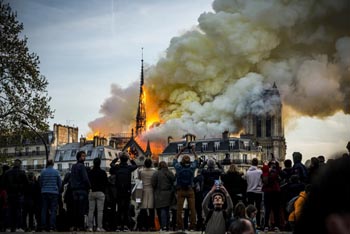
Onlookers watch with grief Notre Dame burning
Therefore, when much of the building was destroyed by fire in 2019, it was cause for grief and consternation, not just in France but around the world. Its iconic steeple and roof, ablaze in fiery flames and billowing smoke, seemed to symbolize our calamitous days.
Now that plans for the redesigned cathedral have been released, this symbolism has taken on added and tragic meaning. If Notre Dame were rebuilt according to plans, it would have been transformed into an icon of the Revolution. No longer pointing to God and Our Lady, it will do the opposite, reflecting our miserablist, secular and ecumenical society.
Upon first examining the plans for the cathedral, some may be relieved. As opposed to the more outrageous proposals put forth in 2019 (such as the swimming pool roof and the greenhouse roof plan), this version leaves the building’s structure largely unchanged. Notwithstanding, its spirit has changed and the newly designed interior has become almost unrecognizable.
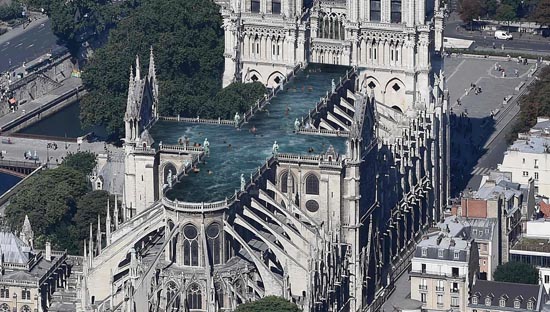
Proposals for a swimming pool on the roof &, below, strange new spires,
were rejected, but the interior was completely changed
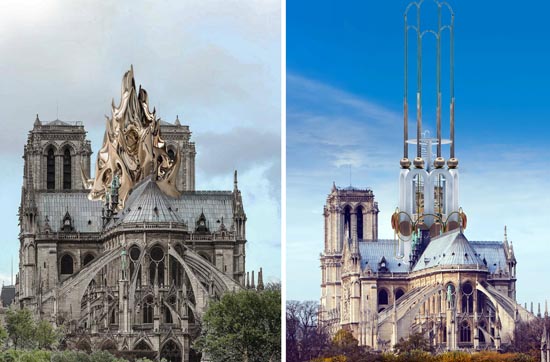
The stone columns, once majestic and solemn, now appear cold. Likewise, the high ceilings, instead of inspiring contemplation of God’s grandeur, make the church seem hollow. There is also a conspicuous absence of crucifixes and statues of Saints.
Whereas the magnificent Notre Dame of old reflected perennial Catholic doctrines, the redesigned interior of the cathedral will be based upon the principles of Vatican II. Designer Guillame Bardet, famous for his “minimalist” style, seems to adhere to the progressivist vision of a “poor and sinner Church.”
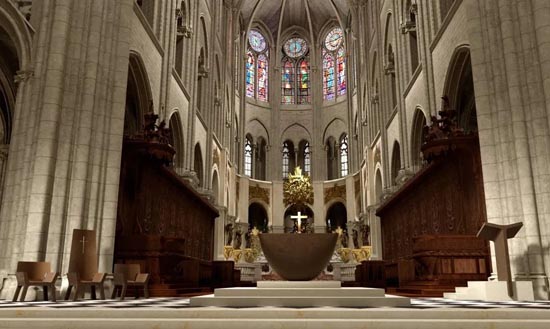
The disconcerting design for the new Notre Dame interior
Bardet notes in an interview that his intention is to “remove everything that is not necessary, and to arrive at the essential, and so the essential is that it is poor.” In the same interview, the rector of the cathedral admits that this idea is based on the Council document Sacrosanctum Concilium, which states: “The rites should be distinguished by a noble simplicity; they should be short, clear, and unencumbered by useless repetitions.”
Bardet’s design is also influenced by Vatican II ecumenism. He boldly states that, “With this work, I am addressing Catholics first, but I also seek to speak to others. To make it clear that we are talking here about religion and, more broadly, spirituality.”
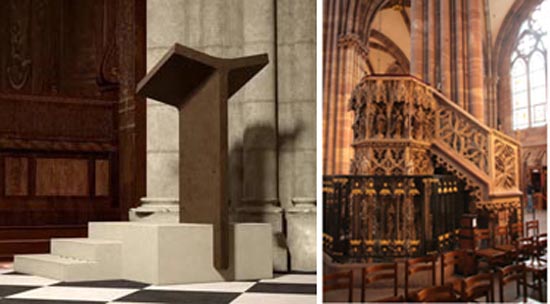
The minimalist pulpit compared with the traditional gothic; below, the ugly modern chairs
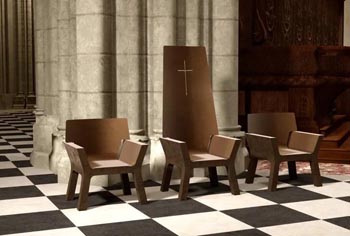
Below, the baptistery, mimicking the Maosnic 'point within a circle' symbol?
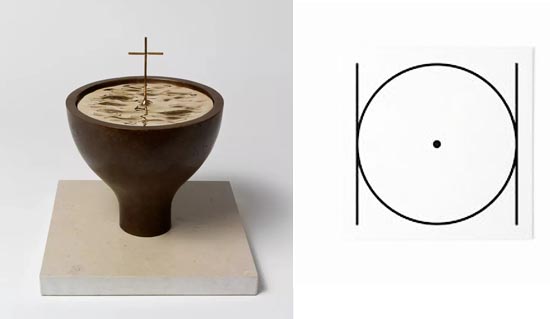
The bare plain altar, below, is unsettling
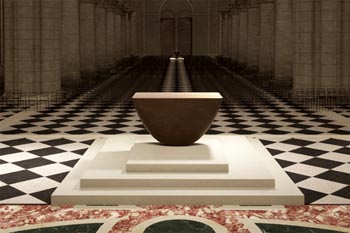
The tabernacle: a triangle box with no sense of a palace for the Real Presence
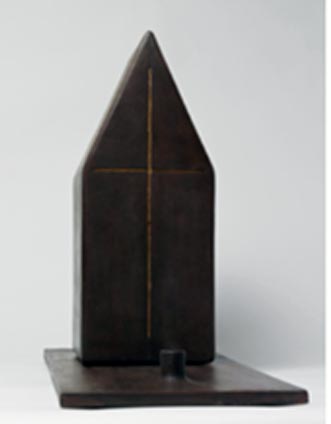
With this framework in mind, it becomes easier to understand the redesigned interior. These Vatican II principles are present in its overall ambiance, as well as in the individual pieces designed by Bardet. They are ugly and common, and do not appear distinctly Catholic. With a few slight modifications – or none at all – they would fit in a Protestant, Muslim, Jewish, or Masonic temple.
First, there are the pulpit and the cathedra. Traditionally, these objects were ornate and made of fine materials in order to symbolize the authority of the Church through her visible representatives. By contrast, Bardet’s designs are made with simple undecorated wood, and both have a note of austerity rather than one of grandeur. They strongly impose the impression of equality between laypeople and the clergy, reinforcing the Protestant idea that a “minister” serves as little more than a worship leader.
Next is the baptistry, which looks just as wretched as the first two objects. Bardet claims it is meant to give the impression of “ritual circularity,” a phrase that sounds more New Age than Catholic. It looks similar to the ancient “point within a circle” symbol, used by Freemasons to represent an individual’s journey toward Masonic “virtues.” Could this be an attempt to rid baptism of its sacramental significance?
The fourth piece, the altar, is particularly distressing. As the altar is the place where Our Lord comes down from Heaven, it should be the richest and most beautiful part of the church. Instead, this one is stark, with a curved, unsettling shape.
Bardet writes that “the evocation of the Last Supper meal naturally imposes horizontality, the altar of sharing.” In other words, he is deliberately de-emphasizing the Church’s doctrine on the Real Presence, giving the impression that the Holy Eucharist is merely a meal. For this reason, the altar looks like a table (or worse than that), with no sacrality at all.
Bardet’s final object, the tabernacle, is equally unfit for Our Lord. Bare and marked only with a thin cross, one would hardly expect it to contain the King of Kings, Jesus Christ. Bardet defends himself by saying, “I chose simplicity by returning to the etymology of the word tabernacle, ‘the tent.’”
This not only obscures the reality of the Real Presence, but also hearkens back to the Old Covenant, in which the Holy of Holies was contained in a tent, the Tabernacle of Moses. Bardet’s work could be seen as an ecumenical gesture, a way to pretend that the Holy Eucharist is of no more importance than what came before in the Old Testament.
The redesigned interior of the Cathedral of Notre Dame is far from the only church to have been hijacked by progressivists. Still, given its great importance in Christendom, this “remodel” will mark a new stage in the Revolution. It will show that the crisis in the Church has reached her very core, aiming to eradicate the last vestiges of the Catholic spirit.
This should remind us, as counter-revolutionaries, of our grave obligation to defend Christ and His Holy Mother and execrate loudly desecrations like this one. As the chastisements approach, let us refuse to retreat from the battle.
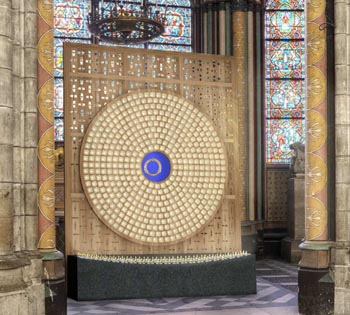
The reliquary to hold the Crown of Thorns looks like
a target practice at a shooting range
- The cathedral was designed to oppose the Cathar heresy. The Cathars denied Christ’s divinity, so the façade of the cathedral is divided into three parts in order to represent the Holy Trinity. https://www.youtube.com/watch?v=i5nODJ3Sum4

Posted March 6, 2024
______________________
______________________
 Volume I |
 Volume II |
 Volume III |
 Volume IV |
 Volume V |
 Volume VI |
 Volume VII |
 Volume VIII |
 Volume IX |
 Volume XI |
 Special Edition |
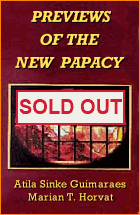 Special Edition |


